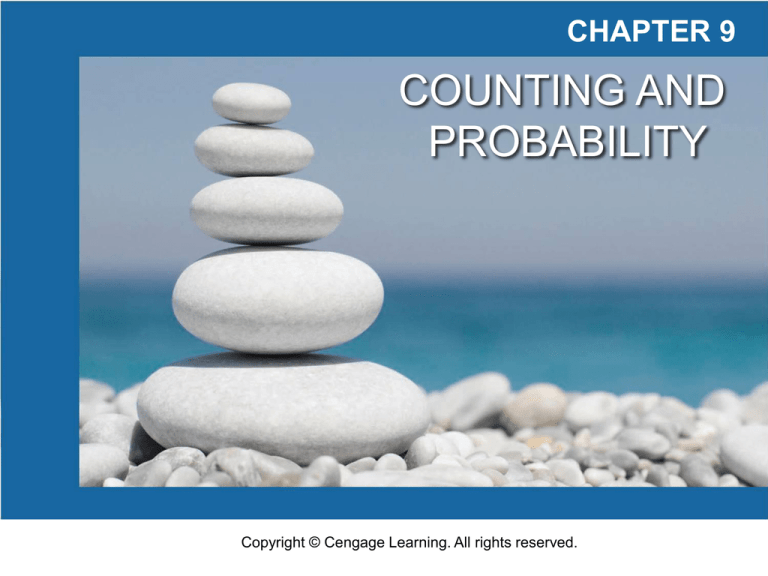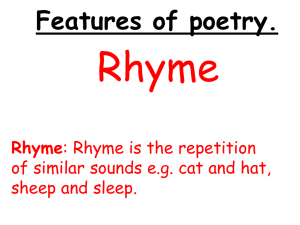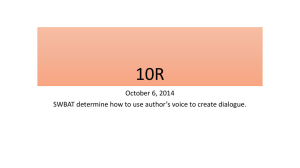
CHAPTER 9
COUNTING AND
PROBABILITY
Copyright © Cengage Learning. All rights reserved.
SECTION 9.6
r-Combinations with
Repetition Allowed
Copyright © Cengage Learning. All rights reserved.
r-Combinations with Repetition Allowed
In this section we ask: How many ways are there to choose
r elements without regard to order from a set of n elements
if repetition is allowed? A good way to imagine this is to
visualize the n elements as categories of objects from
which multiple selections may be made.
3
Example 1 – r-Combinations with Repetition Allowed
Write a complete list to find the number of 3-combinations
with repetition allowed, or multisets of size 3, that can be
selected from {1, 2, 3, 4}. Observe that because the order
in which the elements are chosen does not matter, the
elements of each selection may be written in increasing
order, and writing the elements in increasing order will
ensure that no combinations are overlooked.
Solution:
4
Example 1 – Solution
cont’d
Thus there are twenty 3-combinations with repetition
allowed.
5
r-Combinations with Repetition Allowed
To count the number of r-combinations with repetition
allowed, or multisets of size r, that can be selected from a
set of n elements, think of the elements of the set as
categories.
Then each r-combination with repetition allowed can be
represented as a string of n – 1 vertical bars (to separate
the n categories) and r crosses (to represent the r elements
to be chosen).
The number of ’s in each category represents the number
of times the element represented by that category is
repeated.
6
r-Combinations with Repetition Allowed
The number of strings of n – 1 vertical bars and r crosses
is the number of ways to choose r positions, into which to
place the r crosses, out of a total of r + (n – 1) positions,
leaving the remaining positions for the vertical bars.
7
r-Combinations with Repetition Allowed
But by Theorem 9.5.1, this number is
8
r-Combinations with Repetition Allowed
This discussion proves the following theorem.
9
Example 3 – Counting Triples (i, j, k) with 1 i j k n
If n is a positive integer, how many triples of integers from 1
through n can be formed in which the elements of the triple
are written in increasing order but are not necessarily
distinct? In other words, how many triples of integers (i, j, k)
are there with 1 i j k n?
Solution:
Any triple of integers (i, j, k) with 1 i j k n can be
represented as a string of n – 1 vertical bars and three
crosses, with the positions of the crosses indicating which
three integers from 1 to n are included in the triple.
10
Example 3 – Solution
cont’d
The table below illustrates this for n = 5.
Thus the number of such triples is the same as the number
of strings of (n – 1) |’s and 3 ’s, which is
11
r-Combinations with Repetition Allowed
For instance, in Example 3 we might observe that there are
exactly as many triples of integers (i, j, k) with
1 i j k n as there are 3-combinations of integers from
1 through n with repetition allowed because the elements of
any such 3-combination can be written in increasing order
in only one way.
12
Example 4 – Counting Iterations of a Loop
How many times will the innermost loop be iterated when
the algorithm segment below is implemented and run?
(Assume n is a positive integer.)
13
Example 4 – Solution
Construct a trace table for the values of k, j, and i for which
the statements in the body of the innermost loop are
executed. (See the table that follows.) Because i goes from
1 to j, it is always the case that i j.
Similarly, because j goes from 1 to k, it is always the case
that j k.
To focus on the details of the table construction, consider
what happens when k = 3. In this case, j takes each value
1, 2, and 3.
14
Example 4 – Solution
cont’d
When j = 1, i can only take the value 1 (because i j).
When j = 2, i takes each value 1 and 2 (again because
i j). When j = 3, i takes each value 1, 2, and 3 (yet again
because i j).
Observe that there is one iteration of the innermost loop for
each column of this table, and there is one column of the
table for each triple of integers (i, j, k) with 1 i j k n.
But Example 3 showed that the number of such triples is
[n(n + 1)(n + 2)]/6. Thus there are [n(n + 1)(n + 2)]/6
iterations of the innermost loop.
15
r-Combinations with Repetition Allowed
The solution in Example 4 is the most elegant and
generalizable one.
16
Which Formula to Use?
17
Which Formula to Use?
Earlier we have discussed four different ways of choosing k
elements from n. The order in which the choices are made
may or may not matter, and repetition may or may not be
allowed. The following table summarizes which formula to
use in which situation.
18









